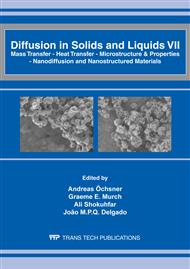p.620
p.626
p.632
p.641
p.647
p.654
p.662
p.668
p.674
Effect of Synthesis Duration on the Physicochemical Properties of Siliceous Mesoporous Molecular Sieve (Si-MMS)
Abstract:
Pure silica mesoporous molecular sieve (MMS) solid has been synthesized at 100°C by hydrothermal process. The effect of synthesis duration from 2 to 10 days has been investigated on the physicochemical properties of mesoporous molecular sieve. Samples were characterized by low angle XRD, N2 adsorption-desorption and HRTEM analysis. XRD patterns of the as-synthesized samples showed four well-defined diffraction peaks corresponding to 100, 110, 200 and 210 planes. These peaks are the fingerprint characteristics of MCM-41 mesoporous material. The high intensity diffraction peaks were observed in 8-days sample that define the high ordering of the pores and long range order. N2 adsorption-desorption results showed that all samples possessed a type IV isotherm having hysteresis loop of type H1 which is an identification of mesoporous material. Calcined samples exhibited high surface area i.e., 984-1036 m2 g-1, pore volume i.e., 1.00-1.13 cm3 g-1 and average pore diameter i.e., 3.04-3.30 nm. A hexagonal pore structure was found in the synthesized materials by HRTEM analysis, which confirms that the synthesized materials are MCM-41. HRTEM analysis showed the effect of synthesis duration on the materials and found that 8-days sample exhibited highly ordered hexagonal pore structure like honeycomb structure. All the samples were calcined at 550°C to remove the template and to study the changes in the mesoporous framework. The results showed that the mesoporous structure remained intact after calcination at 550°C, indicating that the mesoporous materials exhibit high thermal stability.
Info:
Periodical:
Pages:
647-653
Citation:
Online since:
April 2012
Authors:
Price:
Сopyright:
© 2012 Trans Tech Publications Ltd. All Rights Reserved
Share:
Citation:


